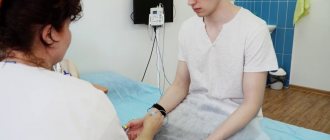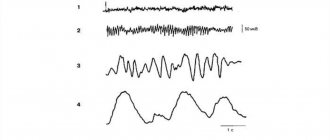When a person feels numbness in their legs
, this means that the sensitive part of the peripheral nerve is affected. Not only sensitivity is lost, but also burning and tingling, tightness, “cottoniness”, goosebumps, coldness, sometimes the accuracy of movements is impaired and a feeling of uncertainty when walking and dizziness occurs. The nerves of the lower limb are numerous, begin in the spinal cord, and branch along their course into many branches. The legs receive nerve impulses through both large (femoral, sciatic, tibial) and small nerves. The central analyzer of sensitivity is the structures of the brain.
The nerves of the lower limb can directly receive mechanical damage (for example, bony outgrowths of the vertebrae, so-called osteophytes, “ossified” ligaments, herniated intervertebral disc), and also be damaged as a result of the inflammatory process or metabolic (metabolic) disorders. CELT doctors, who have modern diagnostic equipment at their disposal, will help you find the cause.
At CELT you can get advice from a neurologist.
- Initial consultation – 3,500
- Repeated consultation – 2,300
Make an appointment
Do you always need to see a doctor?
There is no need to worry only if there is numbness
left or
right leg
occurs once after an uncomfortable position (what is popularly called “served time”). Soon after the physiologically normal posture is restored, the numbness should also disappear. Other harmless reasons include:
- Hypothermia - the human body reacts to cold starting from the lower extremities, so it is best to keep them warm;
- Wearing ill-fitting shoes that are too tight or narrow can lead to numbness in your toes
; - Bearing a fetus - a symptom occurs due to an increase in the volume of fluid in a woman’s body;
- A sedentary lifestyle and frequent sitting leads to numbness in the feet
and legs below the knee.
In all other cases, especially when numbness recurs regularly, it is imperative to look for the cause. Most likely, some pathological process is occurring in the body, and given the extreme “fragility” of nerve fibers and the complexity of their regeneration, delaying diagnosis can lead to irreversible consequences. The following points should be of particular concern:
- there is no obvious reason for the numbness, but it often recurs;
- problems with coordination arise, the leg “clings” or “stammers”;
- walking becomes difficult;
- difficult or impossible to distinguish between warm and cold;
- worries about weakness or dizziness;
- urination is impaired.
These symptoms may indicate a circulatory disorder in the nervous system, that is, they may be signs of a stroke. Or they may indicate acute damage to the nervous system of some other etiology. With such disorders, the timing of medical care is important. For example, if it is possible to restore blood flow in the brain during the first three hours, then there may be no consequences in the form of paresis or paralysis or speech impairment. Modern medical technologies used in CELT make it possible to help those who had no chance yesterday.
Diabetes
Vascular changes occur in diabetic microangiopathy, when there is rapid growth of the inner lining of small arteries and arterioles, followed by closure of the entire lumen. In this situation, the pain syndrome lags behind sensitivity disorders, and numbness of the foot leads to frequent injuries when walking, which do not heal for months.
A neurologist at the international clinic Medica24, having a broad clinical horizon, has at his disposal the most modern diagnostic equipment with the ability to perform complex tissue tests, which affects the patient’s favorable prognosis.
Etiology
Most common causes of numbness in the legs
consist in the presence of pathological processes in the spine - however, this is not all. The etiology of this symptom may be as follows:
- arthritis;
- pathological conditions of a systemic nature;
- multiple sclerosis;
- blood flow disturbances.
The area in which the feeling of numbness is localized will help to more accurately determine the cause.
| Numb area | Diseases characterized by this symptom |
| Hips/thigh |
|
| Above the knees |
|
| Calves of the legs |
|
| Below the knees |
|
| Foot/feet |
|
| Numbness in left leg |
|
| Numbness in right leg |
|
Causes
Paresthesias are sensory disturbances that occur when the nerve plexuses and endings of the spinal nerve roots are affected. Most often they affect the upper and lower extremities, face, neck, and oral cavity. There are the following types of paresthesia: physiological (temporary) and pathological (chronic).
Physiologically determined causes of paresthesia of the arms, legs and face can be the following conditions:
- Staying in a fixed position for a long time. This explains the frequent occurrence of paresthesias of the upper and lower extremities at night: a person uncontrollably finds himself in an uncomfortable position, pressing an arm or leg, and wakes up with the feeling of goosebumps crawling on the skin.
- Trauma or pressure on a specific area of the body that causes mechanical irritation of superficial nerves.
- Wearing inappropriate shoes. This problem is often faced by women who choose shoes with tapered toes, high heels, and 1-2 sizes smaller. Tight shoes provoke compression of nerve endings and poor circulation, causing the development of paresthesia of the lower extremities.
Paresthesia during pregnancy
- Pregnancy. The pregnancy period is characterized by a serious restructuring of a woman’s entire body, so paresthesia at this time is not uncommon. When localized in the lower back and legs, sensory impairment is usually caused by increasing pressure from the fetus on the nerve endings in the lumbosacral area. Hormonal changes that occur during pregnancy can also trigger the appearance of paresthesia.
Impaired sensitivity can be caused by pathological processes occurring in the body. Among them, it is worth highlighting the following diseases and disorders:
- Spinal diseases. Displacement of the vertebrae, hernia and protrusion of intervertebral discs, osteochondrosis, scoliosis, kyphosis, lordosis, oncological processes - all this can lead to changes in sensitivity. Depending on the location of the lesion, paresthesia may affect the upper or lower extremities, neck, and head.
- Radiculopathy. This pathology is also known as radicular syndrome. It develops as a result of compression of the spinal nerve roots and is manifested by pain, numbness and paresthesia.
- Brain lesions. Neoplasms, abscesses, degenerative processes and other pathologies of the brain provoke disturbances in the functioning of the central nervous system and can cause the development of paresthesia throughout the body.
!
If paresthesia affects only one half of the body and the person cannot smile symmetrically, pronounce a simple sentence coherently and raise both arms at the same time, it is important to call an ambulance as soon as possible.
These symptoms are signs of stroke, a pathological condition that poses a serious threat to health and life. Remember: in such cases, minutes count, so it is important that the patient receives medical care in a timely manner.
Leg paresthesia: symptoms
- Polyneuropathy. These pathological conditions develop against the background of alcoholism, diabetes mellitus, cirrhosis, uremia, etc. They are characterized by damage to peripheral nerves and impaired trophism of the distal parts of the lower and upper extremities.
- Neuroses. Paresthesia in neurosis usually develops in response to a serious shock (for example, loss of loved ones, dismissal, psychological trauma), chronic stress, internal psychological conflicts, etc. They usually appear in combination with other symptoms of neuroses - irritability, apathy, tearfulness, panic attacks, insomnia and etc.
- Endocrine diseases. Disruption of the functioning of the endocrine glands provokes a number of changes in the human body, one of which may be a decrease in sensitivity. For example, paresthesia often occurs as a complication of diabetic polyneuropathy.
- Vascular diseases. Violation of the normal functioning of blood vessels leads to a decrease in the trophism of tissues and nerve endings, causing a violation of their sensitivity. Most often, this clinical picture affects the lower extremities. Its development can be caused by obliterating endarteritis, atherosclerosis, thrombosis, thrombophlebitis, phlebitis. Also quite often, sensory impairment is observed with varicose veins of the lower extremities.
Expert opinion
Despite the fact that paresthesia of the legs is a common consequence of diseases of the veins and arteries of the lower extremities, vascular pathologies can provoke sensory disturbances in other parts of the body. For example, numbness and tingling on one side of the face, combined with throbbing pain in the temple and characteristic flashes of light before the eyes, may be a sign of vasospasm, which is observed in migraines.
Vascular surgeon, phlebologist
Osipova Ekaterina Yakovlevna
- Hypovitaminosis. The presence of paresthesia may be a symptom of B vitamin deficiency.
Clinical manifestations
In pathological conditions, numbness of the legs is a symptom that is always accompanied by a number of others. Depending on the etiology, they may be different, but the general picture is approximately as follows:
- Feeling of heaviness in the lower extremities;
- Gait disturbances;
- Inability to distinguish cold from hot;
- Fatigue, constant weakness and weakness;
- Tingling and goosebumps;
- Cramps and increased pain at night;
- Sudden and sharp appearance of pain in the chest and spine;
- Itching and burning of the skin, sometimes blueness;
- Severe headaches and dizziness.
Symptoms and signs of sensory impairment
At first glance, everything is obvious here and the patient must accurately determine the signs of sensory impairment in one or another part of the body. But there is a high danger of inadequate assessment of one’s condition. Sensory impairment may be accompanied by characteristic symptoms:
- feeling of crawling sensations;
- tingling and burning sensation;
- electric current discharges;
- decreased muscle strength.
All these symptoms of sensory impairment allow a more accurate diagnosis to be made and appropriate treatment to be prescribed. Sometimes sensory impairment manifests itself in unexpected ways. For example, a person picks up a hot object and does not feel the heat. But burns remain on the skin. If this situation occurs to you, immediately consult a neurologist.
Diagnostics
The use of modern instrumental diagnostic methods makes it possible to establish the cause quickly enough. Doctors have the following methods in their arsenal:
- radiography - reveals bone deformations, calcifications and other dense formations;
- - allows you to examine the bones and substance of the brain and spinal cord, and other soft tissues;
- MRI - detects defects in almost all structures, the vascular mode gives an objective picture of blood flow;
- electroneuromyography (ENMG of the lower extremities) - reveals defects in neuromuscular transmission;
- Ultrasound or sonography detects cysts, tumors and other formations, allows you to evaluate the structure of blood vessels;
- general clinical and biochemical blood tests.
CELT doctors have accumulated vast clinical experience, daily comparing data on various diseases. Specialists will be able to find out the exact cause of suffering and suggest the most effective method of treatment so that everything ends in recovery.
Diagnosis of the disease
To determine the disease, the doctor conducts a visual examination, studies the patient’s history and complaints. For example, the condition of the skin, its color and temperature are checked. Laboratory diagnostic procedures are also carried out:
- blood analysis;
- toxicological analysis;
- MRI of the spine, head;
- Ultrasound of cervical vessels;
- X-ray of legs;
- diagnosis of the thyroid gland.
Our doctors
Pankov Alexander Rostislavovich
Neurologist
40 years of experience
Make an appointment
Novikova Larisa Vaganovna
Neuropathologist, Candidate of Medical Sciences, doctor of the highest category
Experience 39 years
Make an appointment
Treatment
Any numbness that occurs several times over a short period of time—a week or a month—requires consultation with a doctor. The sooner the cause is identified, the greater the chances of a positive outcome. You need to understand that a nerve is a dynamic formation that has its own extremely complex physiology. For severe damage to nerve tissue, intense exposure to any pathogenic factor for just a few minutes may be enough, and nerve regeneration takes months. The nerve can be kept healthy or fully restored only if measures are taken in time.
Treatment of numbness in the legs
, first of all, is aimed at eliminating the cause that caused this symptom. Its selection is carried out individually, based on diagnostic data, situation and indications of the patient. The treatment itself is carried out in a complex and may include the following:
| Techniques | Features of application |
| Drug therapy |
|
| Manual therapy | Therapeutic techniques aimed at eliminating blocks in joints and muscles that lead to compression of nerve roots and blood vessels, as well as stimulating blood flow in the affected area. |
| Physiotherapeutic procedures | Using techniques aimed at stimulating blood flow in the affected area:
|
| Exercise therapy | Performing a set of individually selected exercises under the supervision of an instructor will help strengthen the muscle corset around the spine, stimulate tissue trophism and blood flow. |
Prevention
In order to eliminate such a manifestation as numbness of the legs, you must adhere to simple rules, which are as follows:
- Rejection of bad habits;
- Reducing salt intake;
- Active lifestyle;
- Proper, balanced nutrition;
- Providing the body with all the microelements and vitamins it needs;
- Avoiding high-heeled shoes or keeping them to a minimum;
- Sports activities;
- Attention to your health;
- Timely seeking professional help if certain symptoms occur.
MC CELT specialists give a positive prognosis for timely treatment of numbness in the legs. Trust your health to professionals!
Make an appointment through the application or by calling +7 +7 We work every day:
- Monday—Friday: 8.00—20.00
- Saturday: 8.00–18.00
- Sunday is a day off
The nearest metro and MCC stations to the clinic:
- Highway of Enthusiasts or Perovo
- Partisan
- Enthusiast Highway
Driving directions
Chronic diseases
In chronic neurological pathology - multiple sclerosis, the development of a symptom is also possible, but with this disease there are also other neurological manifestations.
With the deposition of uric acid salts associated with its excessive intake from food and a genetic disorder of acid excretion, the deposition of lumps of acid in the joint of the first toe is typical, which is accompanied by pain and loss of sensitivity, sometimes numbness precedes the pain.









